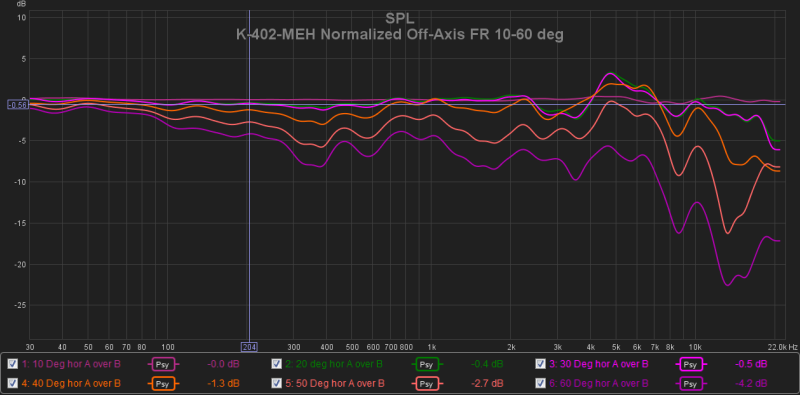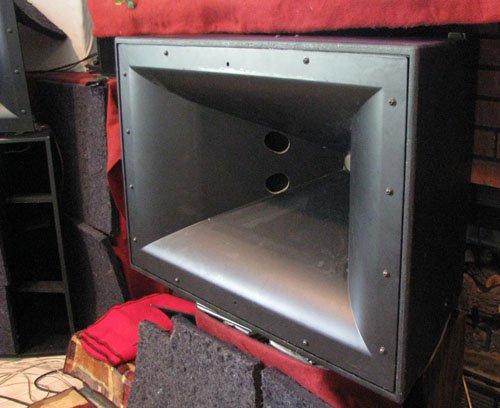Search the Community
Showing results for tags 'unity horn'.
-
(Lots of hyphens in that title...I like it... I bet this topic has your full and undivided attention if you're here reading this.) So let's get into the basic idea: crossing the ideas of Mr. Roy Delgado and Mr. Tom Danley on horn design, namely using a K-402 as the basis of a multiple-entry horn design--like the Unity Horn design of Sound Physics Labs. The Synergy Horn of Mr. Danley is still patented (US8284976), but this design reuses the exact physical design of the Unity horn (US6411718--expired). If you cross the woofers over at the first notch frequency, there is no patent infringement. The K-402-MEH is a cross between the K-402 horn used on Roy's Jubilee (the real secret of the Jubilee, IMO) and the multiple-entry horn design of Tom Danley. So neither of these topics are controlled by legalities except of course the names that may be copyrighted by Klipsch and Danley Sound Labs, so I'll just refer to this new design as my "New Center" design, since I'm currently using it between two 2-way Jubilees as a center loudspeaker. What am I really talking about? Perhaps some pictures will help: The horn itself with drivers attached: So the first question is: why? That's pretty easy: I needed a better center loudspeaker between my Jubilees, but the size of another Jubilee is not possible to accommodate in my room. So I reused the horn profile of the most important horn--the high frequency K-402 horn used in the Jubilee--in a full range loudspeaker design. How can you do that? Isn't the K-402 just a HF horn? Well, the answer is: no, it isn't only a high frequency horn. We'll get to that in more detail as time goes by. Suffice it to say that the K-402 is used, unchanged, in the KPT-305 mid-bass module used by the 4-way behind-the-screen cinema systems. This module goes down to about 200 Hz using only a puny 8" driver that Klipsch provides. So the K-402 horn is good from at least 200 Hz to 20 kHz. I was needing more low end than just 200 Hz, so I decided to try my hand at a multiple entry design that reuses the aperture of the K-402 for both the bass woofers and the apex-mounted 2" compression driver. How does that work? Basically, you take two or more woofers and mount them on the sides of the back of a K-402 horn and provide through holes through the side of the horn at the right places to provide a secondary entry point for the bass frequencies, while the rest of the horn behaves like a K-402 horn with 2" compression driver. Two for one, basically. No Jubilee bass bin is used. Besides the fact that the Jubilee bass bin is exceptionally large, by itself, as a center loudspeaker, it just isn't possible to use the Jubilee bass bin in my case. But I still wanted everything else that I get from my Jubilees on either side, and I want this center loudspeaker to seamlessly integrate in terms of its timbre, coverage angles, and in all other sonic performance areas. In addition I get a few things that I don't get with the Jubilees: 1) point source loudspeaker performance (more on this topic later). [This is a big deal that Danley has been capitalizing on of late. Using separate horns for each way of loudspeaker has interesting issues that few people typically think about.] 2) I avoid the issue of dual-mouth bass bin polars at the crossover frequency that the Jubilee bass bin has. In fact I get the same polars all the way through the crossover region--something that is an issue for the Jubilee (refer to the EASE data for the Jubilee). I get full polar coverage up to and through 600 Hz and above. The Jubilee bass bin has issues starting at 200-300 Hz in this area due to its two bass bin mouths. 3) I don't have any folds in the horn. The advantages of this are many, and have been discussed in detail in the forum threads many times. 4) The cost of the center loudspeaker is about 1/3 of a full-up Jubilee. This isn't a trivial point to consider. It's also much less cost than Danley Synergies. 5) I don't need a corner of the room in the center of my setup to get good bass response, like the corner-located Jubilees need. Danley Synergies also have an issue in this regard (except the SH-96). EDIT (21 March 2019): a more recent measurement at ±1 dB resolution using new PEQs, Danley-style crossover filters, and tri-amped. The compression driver is a BMS4592ND (dual diaphragm) making the K-402-MEH a three-way design. Note the -3 dB frequency on the low end (16.5 Hz): EDIT 7 November 2021: There is a new 2 inch compression driver on the market that makes the job of the woofers easier and produces an even better result--the Celestion Axi2050: More REW measurements, like spectrograms, harmonic distortion, can be found on this page: A discussion of MEH crossover filters (focusing on the Danley SH-50 design): Polar performance is summarized in this plot (normalized curves to the on-axis response, 10-60 degrees off axis from centerline, or otherwise stated...20-120 degrees included angle) (EDIT 25 Oct. 2018: These polar response plots will be updated soon to reflect a more successful crossover filter overlap scheme): EDIT (4 March 2018): A normalized spectrogram of the horizontal polar performance using OmniMic (freeware): The -6 dB point is the blue-green color in this plot. This is spectacular directional performance down to 100 Hz, which is solely due to the dimensions of the K-402 mouth. This is significantly lower than the nominal polar cutoff frequencies for virtually all other horns used in home consumer environments. The effect of having such low frequency directivity available is outstanding in-room performance and ability to couple to the boundaries without polar lobing effects much more effectively than even the Jubilee bass bin. This is outstanding polar directivity performance that I have not seen in any other loudspeaker. 6) All of these advantages will also work even better for those that might want to use this design instead of Jubilees in the corners--except in a package that is about 1/3 the size of a Jubilee--essentially the same volume and form factor as a La Scala II, and about the same weight (190-200 lbs). 7) You can use this loudspeaker in a vertical orientation--like the difference between a regular and vertical Cornwall--without having to change out the internal baffle. The horizontal coverage can then be 60 degrees instead of 100 degrees. Ceiling bounce issues can be controlled at the loudspeaker in this orientation. Etc. Why doesn't Klipsch do that already? Probably because the Jubilee is aimed at the Cinema marketplace, which requires much higher average SPL. Secondary to this have been the patent issues that have more recently been resolved by the expiration of the controlling patent. Why not use a Danley Synergy Horn instead? Well, price for one. And all the Danley products are designed for PA use - even higher SPL than Cinema. This means that the requirements that they have been designed to don't match the needs of the home hi-fi enthusiast, like myself. Additionally, the K-402 horn is a better horn than the Danley dual-flare conical horns, in terms of polar control and coverage angles. The Danley Synergies used at home have been the SH-50 or SH-60 designs, which have about half the horizontal coverage angle that I need in my listening room, and they have insufficient low frequency headroom relative to the modified K-402 with two 15" woofers. You would have to buy two Danley SH-96s to have two stereo loudspeakers, and those units apparently go for $8363(US) each--they have 11 drivers in each cabinet which is neither necessary nor useful for the home hi-fi enthusiast, and those drivers cost real money. This K-402 design is much more "fit for purpose" than any of the current Danley designs. Danley SH-96 Polars: Danley SH-50 polars: Chris
- 1210 replies
-
- 4
-

-
- unity horn
- synergy horn
-
(and 3 more)
Tagged with:
-
https://en.wikipedia.org/wiki/Horn_loudspeaker#Multiple_entry_horn I think it's instructive to understand what a multiple entry horn (MEH) is and why it works so well. I'll take some excerpts (with revisions) from a white paper on the subject: _________________________________________________________________________________________ Horns are beneficial in radiation of acoustic energy across the audible band of frequencies. To make horns useful for loudspeaker design, it's important to: 1) provide good loading for the loudspeaker drivers [for higher efficiency], and 2) provide uniform directivity control across as wide a frequency span (bandwidth) as possible Reproducing the frequency spectrum typically requires multiple drivers of varying sizes. Using traditional design methods, this puts the loudspeaker drivers and/or horn mouths at different physical locations. Using that approach, It's difficult to maintain a uniform radiation pattern throughout the crossover region from one device to the next. For directivity control at low frequencies, size is required. For instance, to achieve full 50° pattern control from a horn at 170 Hz, a mouth size of approximately 40 inches is required... So there is a size advantage to be able to use one large horn instead of multiple horns. Using one large horn while maintaining reasonable enclosure size is the goal. Coaxial horn arrangements have been used in the past, i.e., nesting smaller high frequency horns inside a larger mid frequency horn (or driver cone). Another design is to have the drivers for each frequency region all drive the same horn. Both of these methods have the advantage of using the entire front area of the loudspeaker enclosure as the horn mouth. Multiple entry horns [MEHs] couple the radiation from multiple drivers into a single horn to approximate the performance of a single horn/driver system with high efficiency and excellent directivity control. A straight-sided horn can yield very consistent directivity control over a wide frequency range. The problem with using a straight-sided horn is that it does not provide good low frequency loading to its driver (if the low frequency driver is located at the throat of the horn). The loading a horn presents to a driver can also be viewed as the expansion rate of the horn. A 125 Hz exponential horn has an expansion rate that doubles its cross sectional area every 6 inches of horn length while a 500 Hz exponential expansion doubles its area every 1.5 inches... A straight-sided horn expansion has an expansion rate that is very rapid close to its apex (throat)--it doubles its area in a very short distance, but as the distance from the throat is increased toward the mouth, its expansion rate decreases. For every point along the axis of the straight-sided horn, there is a different expansion rate and in turn a different low frequency cut-off. Straight-sided Horn Low Frequency Cut-Off By using this effect, a straight-sided horn can be driven at the appropriate place along its length to yield good low frequency loading on the woofers. This is one of the principles governing the driver placement within the MEH: lower frequency drivers are placed closer to mouth where the horn provides better loading within the frequency region (pass band) where these drivers are used. There are several other similar principles that dictate the driver placement for each pass band within the MEH. When these constraints are observed, the result is that multiple drivers operating in multiple frequency ranges are very effectively coupled into a single horn. ________________________________________________________________________ MEHs are new compared to traditional multiple-horn horn loudspeakers, and they have real advantages over them and few if any disadvantages. From another thread on this subject, here are some advantages over traditional horn loudspeaker designs: They increase measured and subjective clarity over other conventional fully horn-loaded loudspeakers due to their point source capability & undisturbed constant directivity (i.e., no lobing). Properly set up, and without requiring FIR filtering, they have almost linear phase behavior as compared to other full-range horn loaded and direct radiating multiway designs. They can have useful directivity from 110 Hz-17+ kHz (depending on HF driver)--the same as the Khorn and Jubilee, and more effectively take advantage of room corners to further directivity and boundary gain below 110 Hz due to their large mouth size, the absence of bends in the horn path, and small form factor. They don't require a corner to have -3 dB roll off response down to 32 Hz (albeit without the advantage of its own directivity gain below ~70-90 Hz). A full-range MEH loudspeaker can have a 1/3 size form factor as compared to a Jubilee. They can have high efficiency of horn-loading. They typically have significantly lower costs of production over a typical corner horn loudspeaker. That's a significant set of advantages over a corner horn or other fully horn-loaded loudspeaker, and is something that even the "full range" driver aficionados (e.g., Fostex, etc.) are looking for, but can't really achieve. The downside of MEHs? No downsides are implicit in their design, but there are some design considerations that must be realized: Their bass performance, like the corner horn, must either make use of the room's boundaries (i.e., quarter space along a wall/floor interface or eighth space corner loading) must be used to supplement their bass extension, or their bass response must follow the same efficiencies as slot-loaded bass bins, i.e., like bass reflex, etc., and this can mean higher modulation distortion and lower bass efficiencies below the horn loading frequencies. Their crossover designs can be quite challenging. By this, I mean that if you are thinking about using a passive crossover in a three-way MEH design, be prepared to spend significantly more time tweaking the crossover filters than in a standard direct radiating or multiple-horn loudspeaker. Fortunately, the advent of very high quality and economical DSP crossovers and bi-/tri-amping makes this trivial. Their mouth form factors are generally square to golden rectangle (1.618:1) ratios. This means that they are not "slim and tall", but rather rectangular or square, and they have about 15-25 inches of depth. If you want full-range operation of the MEH itself, the horizontal and vertical dimensions of the horn mouth will be ~35x21 inches. If you're willing to give up directivity of the bass below ~500 Hz and use a direct radiating bass bin under or over the MEH itself to complete it's frequency response capability, the mouth size of the MEH can be as small as 13.5 x 7 inches but the real advantage of MEHs is lost when you do this, IMO. Chris
- 19 replies
-
- 4
-

-

-
- synergy horn
- multiple-entry horn
-
(and 1 more)
Tagged with:











